The annual New Zealand Book Awards for Children and Young Adults are a highly anticipated part of the Aotearoa literary calendar, for folks of all ages who have a passion for books for young people. They acknowledge excellence in writing, illustration and publishing, and provide a vital platform to celebrate the best and most vibrant things going on in the kids’ lit scene.
There are six main categories, with prize money of $7,500 to each winner. There’s also a Best First Book prize of $2,000, awarded at the judges’ discretion to a previously unpublished author or illustrator. The big moment of the night is the presentation of the Margaret Mahy Book of the Year Award, worth another $7,500, which is selected from the category winners.
Since Briar Lawry, one of The Sapling’s editors, is on the judging panel this year, all award-related coverage and hot takes are being provided by our other editors and contributors, with no cross-pollination.
What follows is a brief selection of stats on what the make-up of the finalist lists look like – along with commentary from Sarah Forster, Nida Fiazi, and Simie Simpson on what our picks are for each category. We can’t let Briar have all the fun!
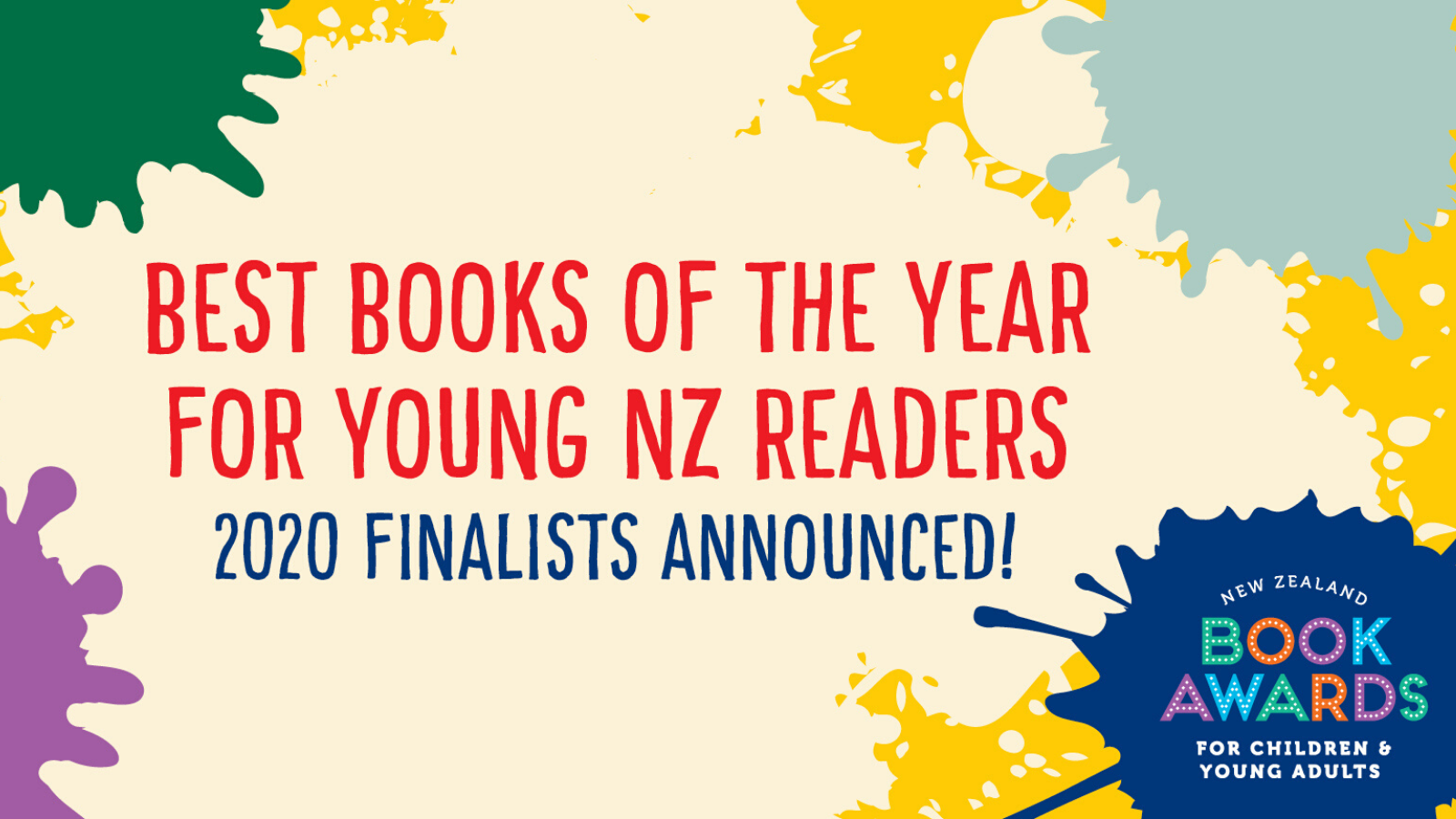
Crunching THE NUMBERS…
There are 16 publishers represented in this year’s finalists, 10 of which are local presses and six of which are part of larger international organisations. But who’s popping up the most?
Huia Publishers and Scholastic NZ both boast finalists in five categories – Scholastic with one per relevant category and Huia Publishers with seven finalists across the five categories.
Scholastic NZ is once again on top when it comes to sheer numbers, with five different titles. Huia Publishers come in second, with three or five books represented, depending on which way you cut things, with English and te reo Māori versions of two titles featuring.
Huia Publishers and OneTree House both have categories where they are competing against themselves – Huia has two finalists in the Best First Book and Te Kura Pounamu categories, and OneTree House has two finalists in the Young Adult Fiction category.
For the first time in NZCYA Awards history – to the best of our knowledge – there are two university presses up for prizes! Auckland University Press is up for one category, while Massey University Press has three titles across four categories. It’s awesome to see organisations with connections to different sorts of writers and specialists jumping into the children’s literature ring more these days. Lift Education, who primarily work in direct school supply, are also up for one category, making this an academically rigorous year indeed.
That’s things from a publisher perspective for now, how about some other breakdowns?
Last year, when Briar wasn’t a judge but was helming The Sapling’s awards coverage, she noted the major skew towards women among the finalists (‘There are five finalists in six of the categories, and three finalists in Te Kura Pounamu – so 33 different finalist slots. 24 of 33 are women, with four of the nine male finalists coming under the Best Illustration category. Perhaps that’s a call to arms for male writers with a yearning to write a children’s book…’). We think Briar’s call to arms last year was a success as there are more men in each category this year—although Te Kura Pounamu and the Junior Fiction are still dominated by female finalists.
As with last year, there are plenty of familiar names. Every main category has at least one previous finalist or winner, showing that the best authors and illustrators of Aotearoa remain consistently on top of their game. Another really important observation is that there are people of colour represented in the finalists of every category, and Māori finalists across six of the seven categories.
Basically, it is a stacked, and pretty darn diverse line-up! Not to mention the fact that this year four of the five finalists for Best First Book are also finalists in their respective categories.
THE PICTURE BOOK AWARD FINALISTS
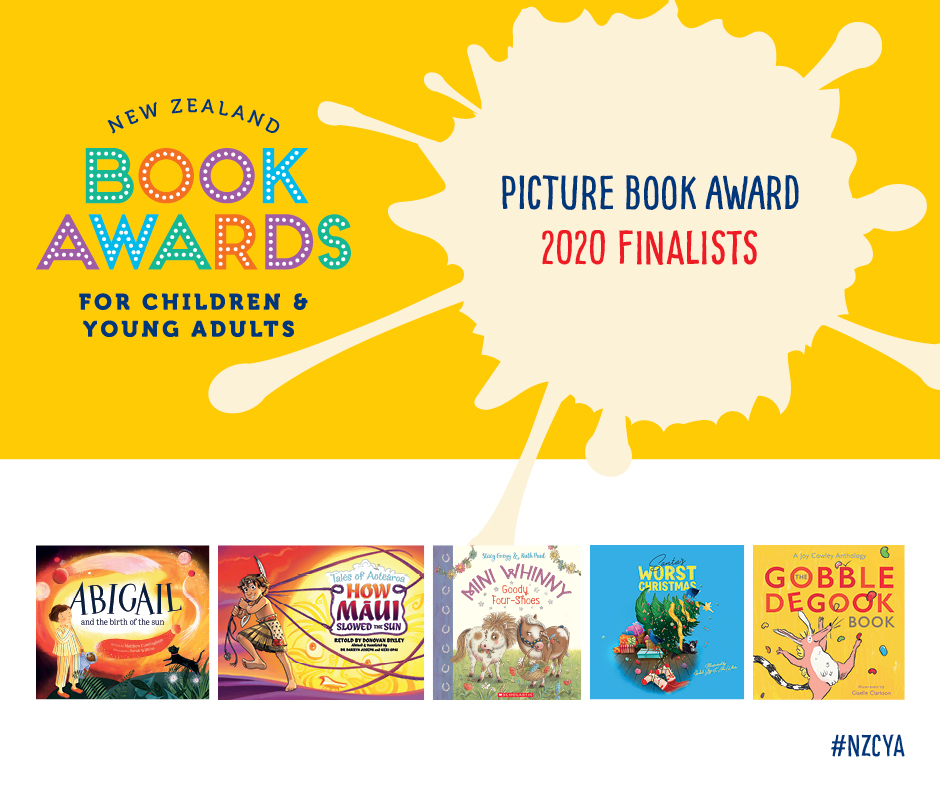
Abigail and the Birth of the Sun, by Matthew Cunningham and Sarah Wilkins (Penguin Random House)
‘My students were absolutely fascinated by the concept of us all being made from stardust, and it was lovely to watch the wonder on their faces as I read the story.’ – Rachel Moore, The Sapling
How Māui Slowed the Sun, retold by Donovan Bixley, advised and translated by Darryn Joseph and Keri Opai (Upstart Press)
This the second in the Pūrakau o Aotearoa / The Tales of Aotearoa series that re-tells the stories of Māui.
Mini Whinny: Goody Four Shoes, by Stacy Gregg and Ruth Paul (Scholastic NZ)
The sequel to the mischievous little Mini Whinny books, this is a tale of friendship and jealousy. Interview between Donovan Bixley and Ruth Paul.
Santa’s Worst Christmas, by Pania Tahau-Hodges and Bryony Walker, illustrated by Isobel Joy Te Aho-White (Huia Publishers)
In this Aotearoa Christmas picture book, the kids come up with a clever plan and amazing gadgets to get Christmas back on and Santa back in the sleigh delivering presents.
The Gobbledegook Book, by Joy Cowley and Giselle Clarkson (Gecko Press)
‘This is a collection of big words, brilliant rhythm and rhyme, and wacky stories…’ – Michele Powles, The Sapling
Sarah: Picture books are always the largest field, and generally the strongest as well. For me this year it’s between newcomer Matthew Cunningham (with award-winning illustrator Sarah Wilkins), and Joy Cowley with Giselle Clarkson. Abigail and the Birth of the Sun is a fabulously whimsical story which tells a scientific lesson, and I feel like while The Gobbledegook Book is sheer fun, it does include stories and poems that have been seen before, so perhaps the time for Abigail and her creators is here.
Nida: Oooh this is a tough one. I adore Santa’s Worst Christmas purely for how culturally specific it is—we definitely need more Christmas books like this that are based in Aotearoa. BUT, I think I’d have to agree with Sarah and pick Abigail and the Birth of the Sun. The illustrations are phenomenal (that colour palette is to die for!) and the story took me right back to when I was a kid obsessed with anything and everything to do with space and the solar system.
Simie: Well it’s three for three, and this isn’t an easy choice as l swing like a pendulum on picture books as they all have individual elements that I love. Now definitely seems the time for discussions about big things however, and what could be bigger than the story underlying Abigail and the Birth of the Sun? Picture books that talk about art or science while managing to tell a story that is engaging and age appropriate are the bee’s knees for me! It feels like you get more (big?) bang for your buck.
THE Wright Family Foundation Esther Glen Award for Junior Fiction award FINALISTS
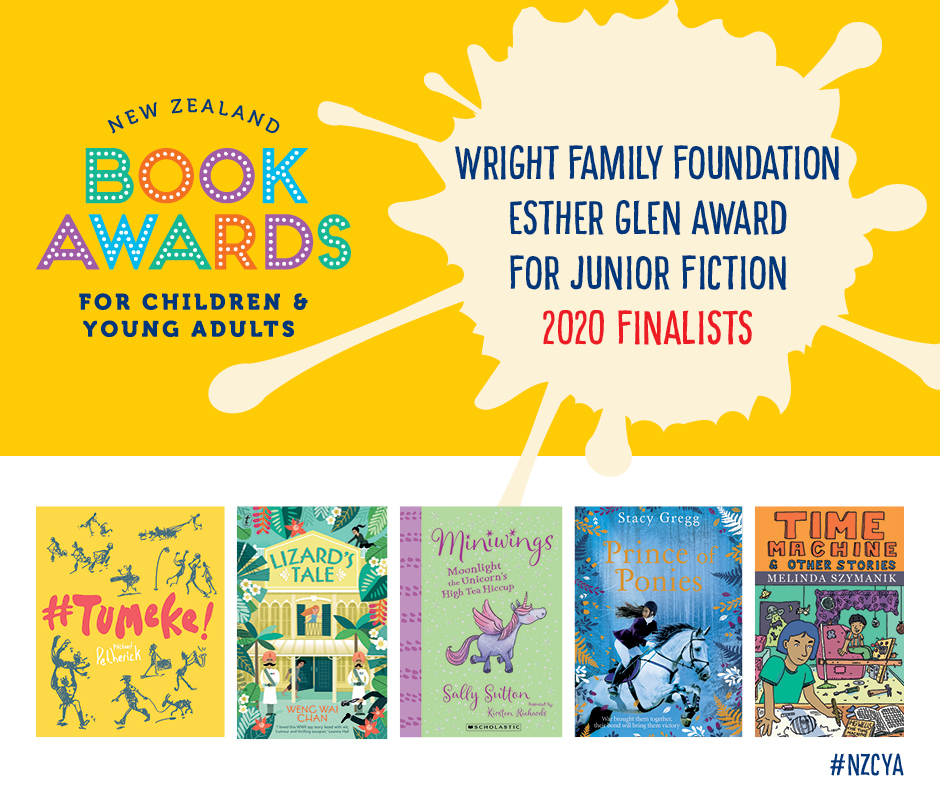
#Tumeke!, by Michael Petherick (Annual Ink/Massey University Press)
‘Laid out in a scrapbook style, it is full of ‘artefacts’ from the daily life of the characters . . . It is a delight to see a fiction book aimed at the middle reader age with such a unique and visually appealing layout.’ – Annelies Judson, The Sapling
Lizard’s Tale, by Weng Wai Chan (Text Publishing)
A middle-grade novel set during WWII about a brave and adventurous boy living by his wits on the streets in Singapore’s Chinatown. Interview with Weng Wai Chan.
Miniwings Book 6 Moonlight the Unicorn’s High Tea Hiccup, by Sally Sutton and Kirsten Richards (Scholastic NZ)
The sixth book in the series about two sisters and their herd of toy horses who come to life when the grown ups aren’t looking, this one involves, cake, grannies and science projects. Interview with Sally Sutton on the Miniwings series.
Prince of Ponies, by Stacy Gregg (HarperCollins)
‘Switching between modern-day Berlin and both Poland and Germany during World War II, this is the story of two courageous girls and the horses they love and protect. In addition to courage, the story touches on themes of the nature of good and evil, racism, bullying, resilience and grit.’ – Rachel Moore, The Sapling
The Time Machine and Other Stories, by Melinda Szymanik (The Cuba Press)
‘This collection of short stories and one novella will be an excellent resource for teachers and librarians.’ – Michele Powles, The Sapling
Sarah: #Tumeke! to me shows the potential for the book to extend storytelling in many different ways, and for that reason, for its sheer imagination, I think that it will take away the prize.
Nida: I love the concept of #Tumeke! but I don’t think it’s for everyone. So I’m going to have to go with Lizard’s Tale for this one. There’s an abundance of WW2 books out there but this is the first I know of that’s set in Singapore, and it explores issues such as belonging, race, and diversity, all of which are very close to my heart.
Simie: I am also team #Tumeke!. When I received a copy of this to review it for another publication, I was worried it was going to be all show and no substance, but it is such a glorious read. It has layers and is clever, funny, and touching all in the one stylish, original package.
THE YOUNG ADULT FICTION AWARD finalists
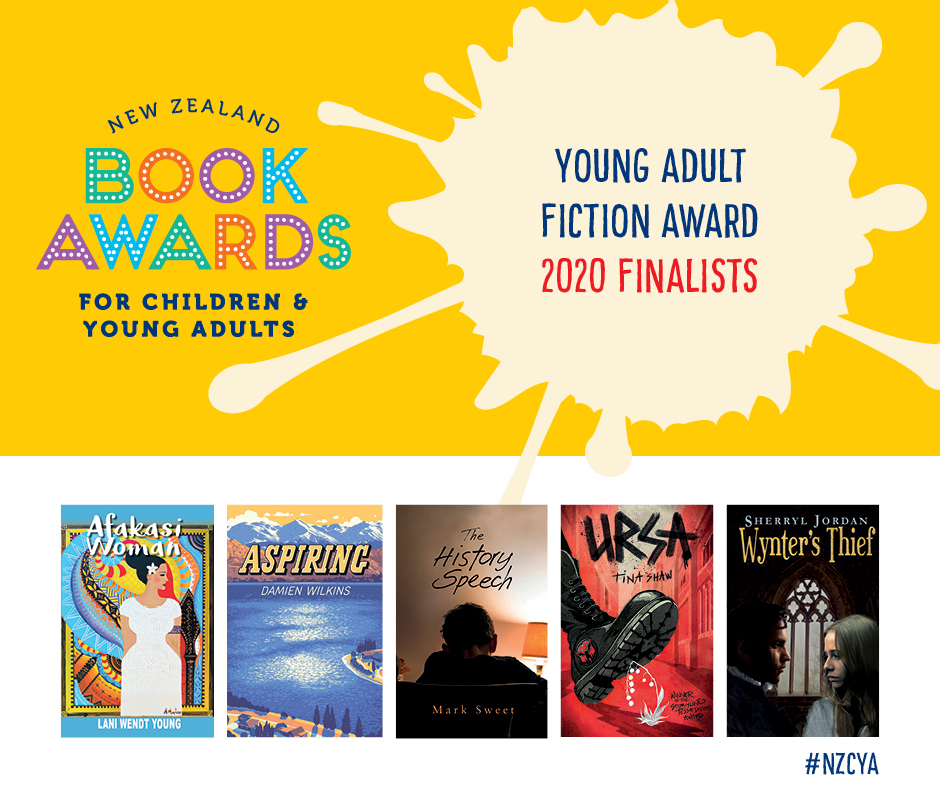
Afakasi Woman, by Lani Wendt Young (OneTree House)
A collection of short stories that capture the lives, loves, laughter and sorrow of Pasifika women. Mahy Questionnaire with Lani.
Aspiring, by Damien Wilkins (Massey University Press/Annual Ink)
The story is one you want to stick with, an elaborate yarn told with honesty and hope, mixed with just enough Kiwi quirkiness to smile about in each chapter. – Dave Tucker, The Sapling
The History Speech, by Mark Sweet (Huia Publishers)
Identity and conflict are explored in this novel about a teen trying to understand his identity in 1960s provincial New Zealand.
Ursa, by Tina Shaw (Walker Books)
This book is a warning that it is too easy to be complicit with our silence and that we need to shout a little bit louder about the issues that affect us all. – Steph Matuku, The Sapling
Wynter’s Thief, by Sherryl Jordan (OneTree House)
A touch of water witch magic is worked in this story of small minds in small villages in medieval England.
Sarah: It’s a tale that has been told 100 different ways by 100 different authors, but Tina Shaw’s Ursa is hard-hitting and gives a new tilt on the story of oppression at the heart of WW2. That’s my pick for the win.
Nida: Afakasi Woman all the way! I love reading stories about POC by POC in general, but the sheer variety in this collection of short stories, the humour, the heart… is just astounding. It’s a brilliant exploration into the struggles of (specifically half-caste Samoan) women, their strength, their love, and there’s even a bit of climate change discussion in there. Lani Wendt Young is a force to be reckoned with.
Simie: I’m torn between Afakasi Woman and The History Speech in this section but I think it is going to have to be The History Speech for me personally, as I am a sucker for coming-of-age stories set in small towns.
THE ELSIE LOCKE AWARD FOR NON-FICTION FINALISTS
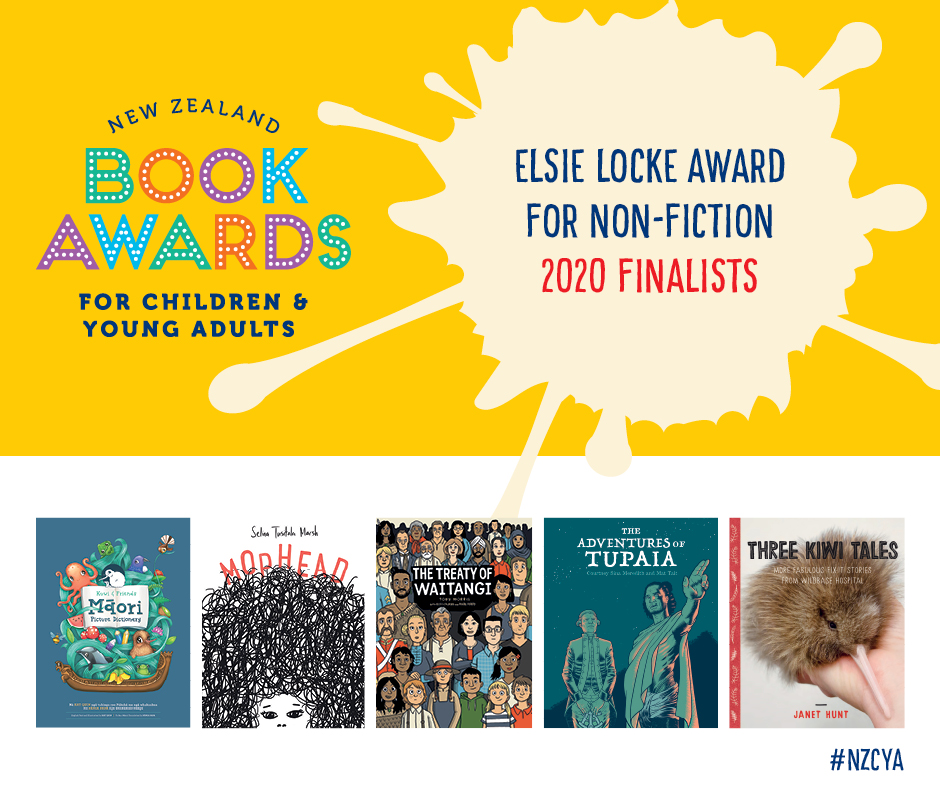
Kuwi & Friends Māori Picture Dictionary, by Kat Quin, translated by Pānia Papa (Illustrated Publishing)
I really had to work hard to give this an objective review but when something comes along that’s this well put together, it’s hard not to feel a little giddy! –Becky Popham, The Sapling
Mophead, by Selina Tusitala Marsh (Auckland University Press)
A playful, poignant and powerful graphic memoir that tells the story of Selina Tusitala Marsh from her childhood to being poet laureate. Interview between Selina Tusitala Marsh and Gavin Bishop.
Te Tiriti o Waitangi / The Treaty of Waitangi, by Ross Calman and Mark Derby, illustrated by Toby Morris, translated by Piripi Walker (Lift Education)
Toby Morris introduces us to learning about the Treaty from his own perspective as a Pākehā New Zealander and his clever and relatable style of illustration shines from each page. – Kay Benseman, The Sapling
The Adventures of Tupaia, by Courtney Sina Meredith, illustrated by Mat Tait (Allen & Unwin)
The story of Tupaia, Tahitian priest navigator, who sailed on board the Endeavour with Captain Cook on his first voyage to Aotearoa. Interview with Mat Tait.
Three Kiwi Tales, by Janet Hunt (Massey University Press)
Three more endearing stories of helping New Zealand Wildlife from the case files of Wildfire Hospital, this is the follow on from How To Mend a Kea. Interview between Janet Hunt and Gillian Candler.
Sarah: OOOH I have no idea how the judges have chosen between these five excellent books. I think, however, that on the whole the winner will be the fabulous Te Tiriti o Waitangi / The Treaty of Waitangi, by Ross Calman and Mark Derby, illustrated by Toby Morris, translated by Piripi Walker. It’s essential reading. I think, as well, that this will win the Margaret Mahy Prize.
Nida: This one is tricky. My top three contenders for this category are Kuwi & Friends Māori Picture Dictionary, Te Tiriti o Waitangi / The Treaty of Waitangi, and The Adventures of Tupaia. I think all of these are necessary reads, for children and adults alike. But if I had to choose just one out of the three to win, it would probably be Kuwi & Friends Māori Picture Dictionary. I hadn’t even realised there was a gap in the industry for such a book until it was out. Now I can’t imagine a world without it.
Simie: Nooo! It is just too hard! This is a difficult category at the best of times because what speaks to readers of different age groups in non-fiction is vastly different, and this line-up is near on impossible. Mophead was a book I read while I waited for a job interview and I was delighted, engrossed and slightly irritated to have to stop reading it, as it made me completely forget why I was there; I didn’t get the job. But I love the illustrations and language in The Adventures of Tupaia. However, Te Tiriti o Waitangi / The Treaty of Waitangi is one of those books that I just want everyone in Aotearoa to own a copy of, and I think it may just come out on top for me.
THE Russell Clark Award for Illustration FINALISTS
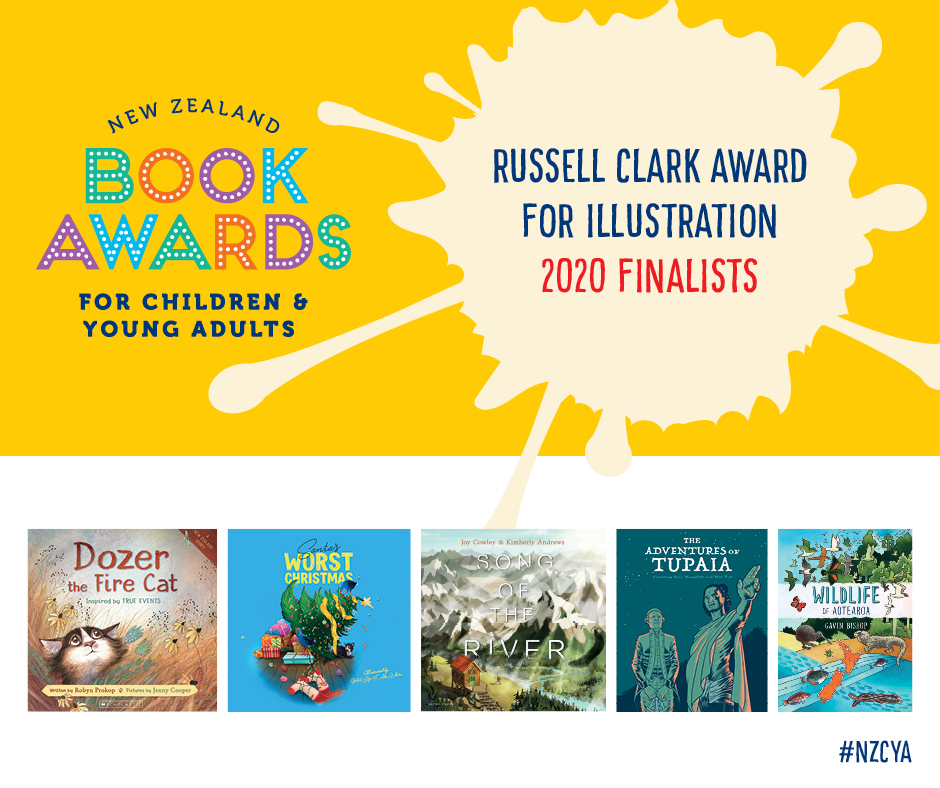
Dozer the Fire Cat, illustrated by Jenny Cooper (Scholastic NZ)
This is a beautifully illustrated tale of Dozer, who gets left behind by his family in the Nelson Wildfires in 2019. – Simie Simpson, The Sapling
Santa’s Worst Christmas, illustrated by Isobel Joy Te Aho-White (Huia Publishers)
In this Aotearoa Christmas picture book, the kids come up with a clever plan and amazing gadgets to get Christmas back on and Santa back in the sleigh delivering presents.
Song of the River, by Kimberly Andrews (Gecko Press)
I defy you to not get lost in the lyrical language and the gorgeous illustrations, which seemed to me to tip their hat to travel posters from the 1940s and 50s while being totally fresh and engaging. – Rachel Moore, The Sapling
The Adventures of Tupaia, illustrated by Mat Tait (Allen & Unwin NZ)
The story of Tupaia, Tahitian priest navigator, who sailed on board the Endeavour with Captain Cook on his first voyage to Aotearoa. Interview with Mat Tait.
Wildlife of Aotearoa, by Gavin Bishop (Penguin NZ)
Following the large-format style of Aotearoa: The New Zealand Story, this stunning new hardback seamlessly weaves its way through New Zealand’s fauna, from ocean to forest, morning to night. – Linda Jane Keegan, The Sapling
Sarah: I fell in love with one of these books on sight, and while I love the work of every single one of these artists, this one takes the cake for me. Song of the River by Kimberly Andrews is lovingly constructed and blows me away with its use of shadows to bring the forest and river alive.
Nida: Oh no! I’m torn between Santa’s Worst Christmas and Song of the River. Both are stunning but in completely different ways. Kimberly’s use of colour and light makes for the most breathtaking landscapes, and I’m in absolute awe of all the uniquely NZ details in Isobel’s illustrations. It almost feels like I’m reading Where’s Wally but a New Zealand edition. Hmmm… I think I’ll have to go with Song of the River, but only because I want to pick Santa’s Worst Christmas as my winner for Best First Book.
Simie: Well, I have a soft spot for Dozer the Fire Cat, I love the detail in the illustrations of the cat, the many and varied poses that speak to an illustrator who has spent some time watching their cat. However, at the risk of creating a chorus, Song of the River is also my pick. Kimberly’s illustrations have a luminous quality that has brought out the depth and detail of this story.
Wright Family Foundation Te Kura Pounamu Award for books written completely in te reo MAAori
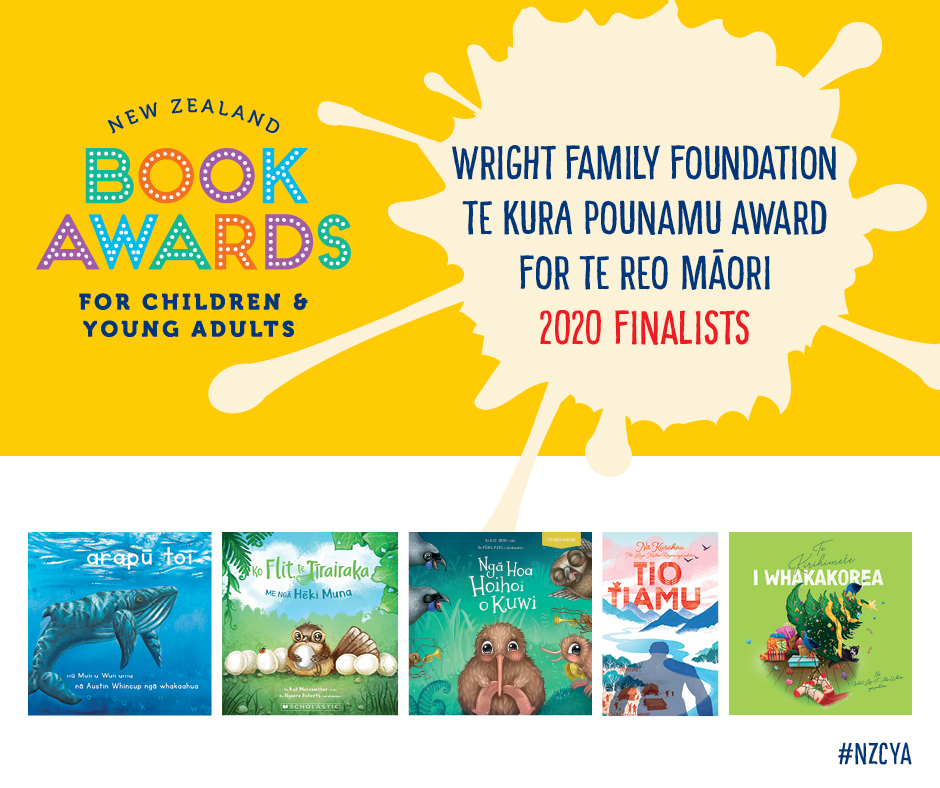
Arapū Toi, by Moira Wairama, illustrated by Austin Whincup (Baggage Books)
He whakamāori o te pukapuka Alphabet Art tēnei pukapuka. I tuhia ngā ruri hou e Moira Wairama, te kaituhi tupu.
Ko Flit, te Tīrairaka, me ngā Hēki Muna, by Kat Quin, translated by Ngaere Roberts (Scholastic NZ)
He pakiwaitara pai tēnei ki ahau. He pai ngā pikitia, he pai te kōrero, he pai hoki te wharangi papakupu! – Anamaria Rogers Pirini, The Sapling
Ngā Hoa Hoihoi o Kuwi, by Kat Quin, translated by Pānia Papa (Illustrated Publishing)
I really had to work hard to give this an objective review but when something comes along that’s this well put together, it’s hard not to feel a little giddy! – Becky Popham, The Sapling
Te Kirihimete i Whakakorea, illustrated by Isobel Joy Te Aho-White, translated by Kawata Teepa (Huia Publishers)In this Aotearoa Christmas picture book, the kids come up with a clever plan and amazing gadgets to get Christmas back on and Santa back in the sleigh delivering presents.
Tio Tiamu, by Kurahau, illustrated by Laya Mutton-Rogers (Huia Publishers)
Ki a mātou nei, e rua ngā whakaaro mātua ki roto i tēnei pukapuka. Tuatahi, he mea kino te mahi whakaweti. Tuarua, ko te akoranga nui ō tēnei pūrākau: manaakitia. Manaaki tangata, ahakoa te aha. – Shirley Simmonds, The Sapling
We will leave our the expert opinions on the reo Māori finalists to those with greater language strength that us.
THE BEST FIRST BOOK AWARD FINALISTS
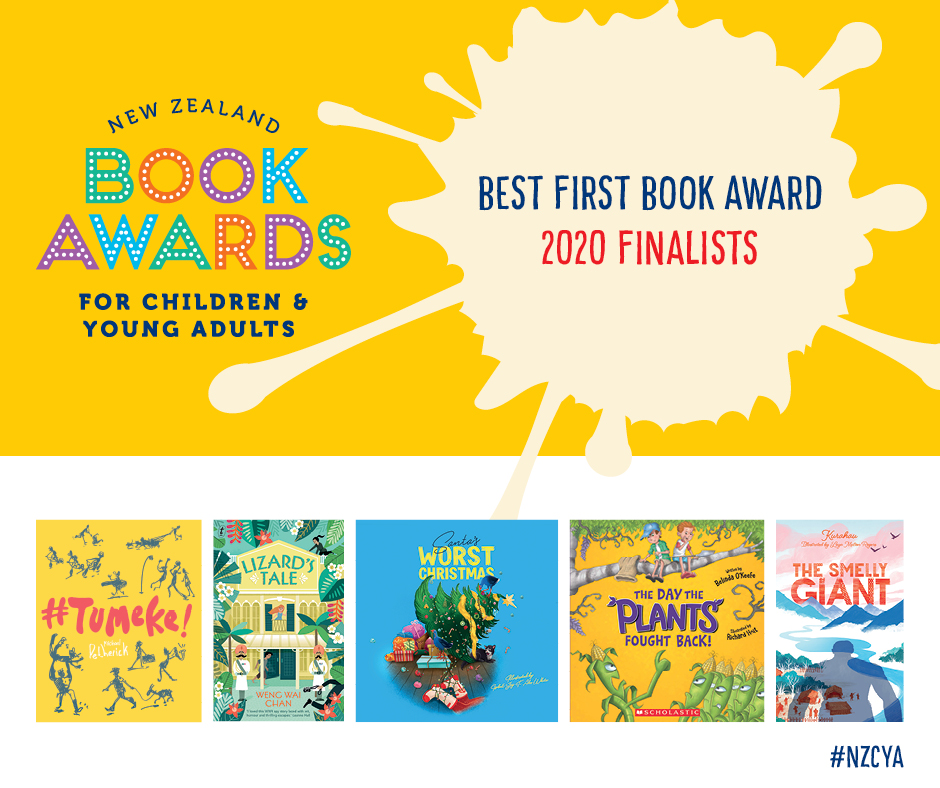
#Tumeke!, by Michael Petherick (Annual Ink/Massey University Press)
‘Laid out in a scrapbook style, it is full of ‘artefacts’ from the daily life of the characters . . . It is a delight to see a fiction book aimed at the middle reader age with such a unique and visually appealing layout.’ – Annelies Judson, The Sapling
Lizard’s Tale, by Weng Wai Chan (Text Publishing)
A middle-grade novel set during WWII about a brave and adventurous boy living by his wits on the streets in Singapore’s Chinatown. Interview with Weng Wai Chan.
Santa’s Worst Christmas, illustrated by Isobel Joy Te Aho-White (Huia Publishers)
In this Aotearoa Christmas picture book, the kids come up with a clever plan and amazing gadgets to get Christmas back on and Santa back in the sleigh delivering presents.
The Day the Plants Fought Back, by Belinda O’Keefe (Scholastic NZ)
A cautionary tale about two boys who behave badly and trash their garden. The plants become furiously animated and band together in war against the children. – Lucy Black, The Sapling
The Smelly Giant, by Kurahau, illustrated by Laya Mutton-Rogers (Huia Publishers)
To us, there were two main ideas in the tale of Toe Jam, the Smelly Giant. Firstly, a lesson about how hurtful it is to tease, ridicule and bully another person. But we thought perhaps the main lesson in this story is; no matter what, treat all people with kindness and respect, no matter how smelly their feet are. – Shirley Simmonds, The Sapling
Sarah: I think this is going to go to a talented new illustrator, Isobel Joy Te Aho-White, for Santa’s Worst Christmas. Her use of colour is striking and fresh and I look forward to seeing her illustrations in the future.
Nida: You already know I’m rooting for Santa’s Worst Christmas. I’ve sung its praises in two previous categories and for good reason! Isobel Joy Te Aho-White’s illustrations do as much of the storytelling as the text itself. It’s incredible.
Simie: Again, #Tumeke! is my pick, as it ticks a lot of boxes for me. I have read this story a few times now, and each time I enjoy it more.



